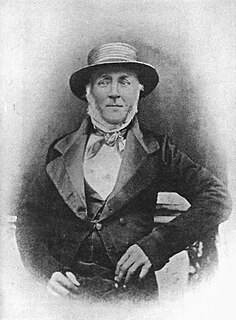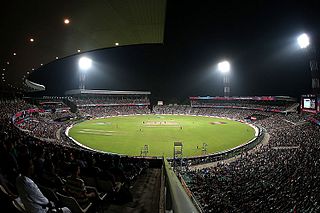
William "Silver Billy" Beldham was an English professional cricketer who played between the 1780s and 1810s. He is generally acknowledged as one of the greatest batsmen of the sport's underarm era. In 1997, he was selected by John Woodcock of The Times as one of his 100 Greatest Cricketers of All Time.
The 1772 English cricket season was the 29th season following the earliest known codification of the Laws of Cricket and the first in which matches have been awarded retrospective first-class cricket status. Details have survived of three first-class matches, all featuring Hampshire sides playing England XIs.

Lord Frederick Beauclerk was an outstanding but controversial English first-class cricketer for 35 years from 1791 to 1825. On his retirement, he served as president of Marylebone Cricket Club (MCC) in 1826.

William Lambert was an English professional cricketer in the first two decades of the 19th century. Playing mainly for Surrey from 1801, but also for Marylebone Cricket Club (MCC) and some other county teams, Lambert was a right-hand batsman and an underarm slow bowler.
The 1774 English cricket season was the third in which matches have been awarded retrospective first-class cricket status. The scorecards of five first-class matches have survived.
1785 was the 89th English cricket season since the earliest known important match was played. Scores & Biographies bemoans the lack of fixtures but there is a historical significance in that state of affairs because it reflected the decline of the Hambledon Club’s influence while the emergence of the White Conduit Club foreshadowed a shift in focus by the cricket authorities from rural to metropolitan.
1788 was the second season of cricket in England since the foundation of Marylebone Cricket Club (MCC). On Friday, 30 May, MCC published a revised code of the Laws of Cricket, calling themselves the "Cricket Club at Marylebone". This action confirmed MCC as the body both in sole charge of the Laws and responsible for the sport's governance. Four weeks later, MCC and its predecessor White Conduit Club played each other at Lord's Old Ground in the earliest match featuring MCC to leave a surviving scorecard.
1790 was the fourth season of cricket in England since the foundation of Marylebone Cricket Club (MCC). It was a successful one for Hampshire who won all three of their known matches, two against All-England and one against Kent. Samuel Britcher, the MCC scorer, began his annual publication of A list of all the principal Matches of Cricket that have been played, a compilation of match scorecards. His 1790 edition features fourteen scorecards, including six from matches played at Lord's Old Ground, the MCC venue.
1792 was the sixth season of cricket in England since the foundation of Marylebone Cricket Club (MCC). Kent played Hampshire at Cobham Park, which was Lord Darnley’s estate and the home of the Bligh family. Ninety years later it became the home of the Ashes in the shape of the urn brought back from Australia by the Hon. Ivo Bligh.
1793 was the seventh season of cricket in England since the foundation of Marylebone Cricket Club (MCC). Surrey teams defeated All-England three times.
1794 was the eighth season of cricket in England since the foundation of Marylebone Cricket Club (MCC). Berkshire had the strongest county team.
1796 was the tenth season of cricket in England since the foundation of Marylebone Cricket Club (MCC). The Montpelier town club became prominent and played a number of matches over the next few seasons against MCC. The club’s venue was George Aram’s New Ground in Montpelier Gardens, Walworth, Surrey.

1800 was the 14th season of cricket in England since the foundation of Marylebone Cricket Club (MCC). It is one of the more difficult seasons to analyse because of several matches involving prominent town clubs like Rochester, Woolwich, Homerton, Richmond, Storrington, Montpelier and Thames Ditton.
1821 was the 35th season of cricket in England since the foundation of Marylebone Cricket Club (MCC). The Gentlemen v Players match was ended in controversial circumstances.
John Wells was a famous English cricketer who played for Surrey.
John Willes was an English cricketer who, though he made only five known first-class appearances, had a significant impact on the game's history and development. Willes played for Kent county cricket teams and was a fast underarm or, when he could get away with it, roundarm bowler.
William Ayling was an English professional cricketer who made 22 known appearances in first-class cricket matches from 1800 to 1810. Ayling was born at Cocking, Sussex and was mainly associated with Kent but latterly played for his native Sussex. He played for the Players in the first two Gentlemen v Players matches in 1806. He died at Bromley in Kent.




